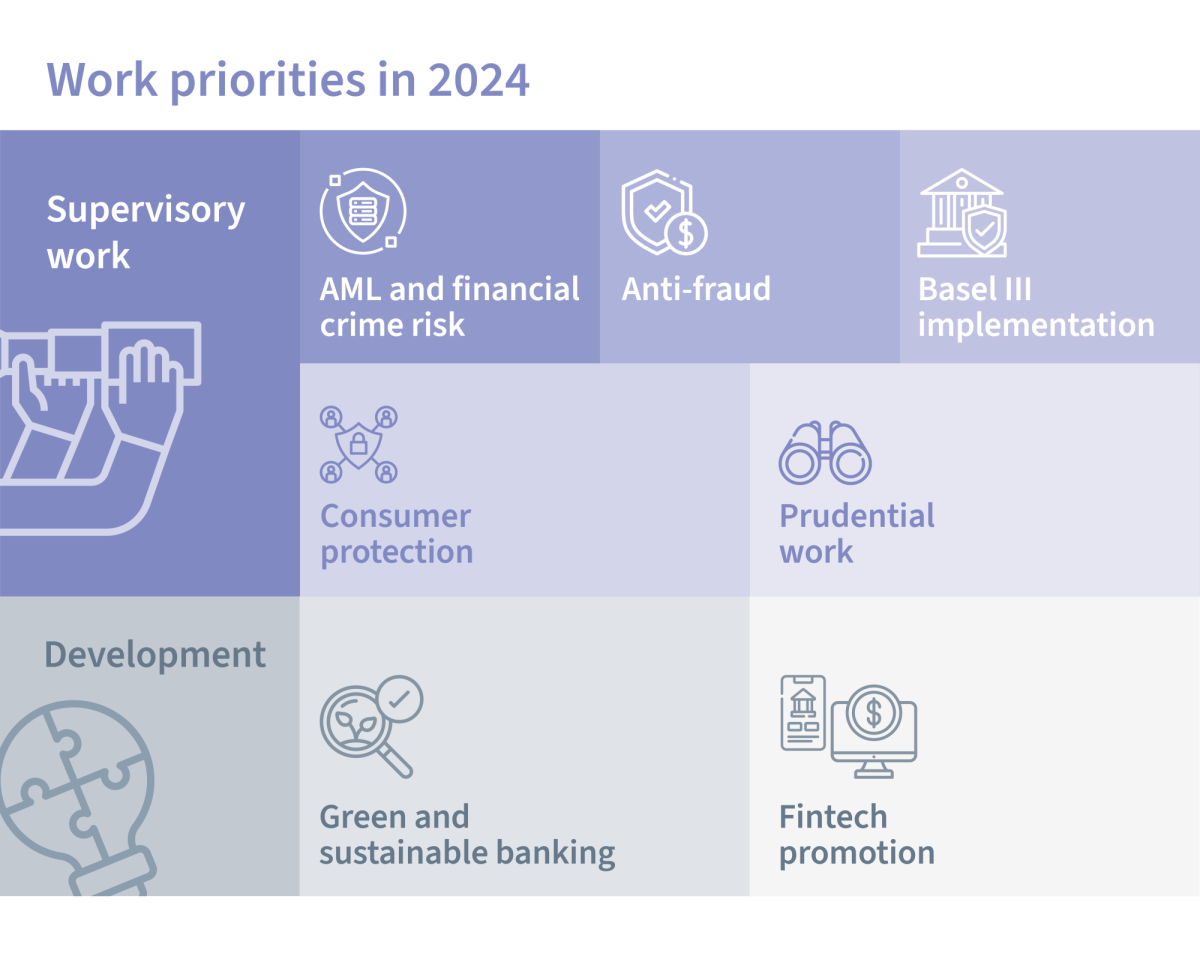Summary
- Financial institutions (FIs) should adopt advanced analytics and collaborate with law enforcement to enforce stricter regulations on financial crimes and customer protection.
- FIs must also develop risk management frameworks to ensure the security of digital assets.
- It is imperative for FIs to adopt a climate risk framework for green and sustainable banking.
- The HKMA continues pushing for innovation through the adoption of financial technology to keep up with the rapid changes in the industry.
The Hong Kong Monetary Authority (HKMA) has released its yearly publication for banking review and priorities, placing emphasis on anti-money laundering (AML) and financial crime risk, anti-fraud measures, customer protection, green and sustainable banking, and fintech promotion. Despite some challenges, the banking system shows resilience with a 20% capital adequacy ratio, alongside maintaining strong asset and credit quality.1 However, the HKMA acknowledges the need for ongoing improvements.

The HKMA document delves into key topics, such as AML, anti-fraud measures, customer protection, green and sustainable banking, and fintech promotion. We will explore the key topics of focus and help you stay ahead of the regulatory curve.


Combatting AML and financial crime risks is vital for maintaining banking integrity and ensuring customer trust. By leveraging advanced analytics and artificial intelligence (AI) in transaction monitoring, targeting high-risk areas, and fostering collaboration through information sharing, FIs are able to uphold the highest standards of security and reliability.
HKMA’s areas of focus
- Macro analytics 3.0: Multi-bank payment data; AI in transaction monitoring (Guidance)
- Target high risk areas: Thematic review of high-end money laundering; risk-based politically exposed person guidance
- Strengthen ecosystem: Expand bank-to-bank information sharing; maximise public-private partnerships
Where banks can improve
Know Your Customer (KYC): Network link analysis (NLA) can enable dynamic risk scoring based on real-time data feeds for continuous screening for sensitive industries, sanctioned countries, and politically exposed persons. It can also demystify complex ownership structures to enable operational effectiveness and minimise fiscal and AML risks.
Transaction monitoring: Incorporating AI and machine learning (ML), facilitated by entity resolution and NLA, can enhance the quality of detection, alert triage, resolution, and SAR filing with an appropriate operating model. End-to-end case management with explainable outcomes can provide transparency into intrinsic AML risk exposure through clients and their transactions.
Client due diligence and enhanced client due diligence: Robotic process automation (RPA) coupled with AI/ML, NLA, and natural language processing (NLP) can reshape the assessment of risk posed by customers. This can be done by streamlining and automating significant and tedious components of due diligence, including investigation and screening for adverse media or sanctions while generating high-quality risk reports for KYC and case management.
To learn the right AML measures for your organisation, contact our topic expert Brandon Lobo at brandon.lobo@synpulse.com.

FIs must prioritise pre-emptive anti-fraud measures, collaborate with law enforcement, and promote education while continuing to adopt innovative methods to safeguard against evolving schemes.
HKMA’s areas of focus
- Pre-emptive and agile responses to digital fraud: Ensuring e-banking security keeps up with fraud landscape; monitoring banks’ implementation of new e-banking security measures; stepping up surveillance
- Collaboration: Further enhance effectiveness of 5 joint anti-fraud initiatives; expansion of Anti-Scam Consumer Protection Charter; strengthening defense against digital frauds with banks and police
- Education and promotion: Latest modus operandi; Mobile point-of-sale terminals; public education
- Innovation: Adoption of network analytics to strengthen real-time fraud monitoring; enhancing suspicious proxy alert model
Where banks can improve
Evaluate your current operations: Review existing processes, procedures, and technology (including validating rules and models) to identify areas where enhancements can be made to achieve more accurate fraud detection and prevention.
Gain industry insights: Industry insights and experiences from peer FIs and fraud prevention vendors can provide valuable perspectives on the most effective best practices and solutions in the field.
Utilise available resources: Having access to a comprehensive range of resources, such as vendor benchmarking and control libraries, can significantly facilitate the efficient and high-quality execution of projects.
Learn how to keep your organisation safe with effective anti-fraud measures. Contact our topic expert Farhad Patel at farhad.patel@synpulse.com for further information.

Safeguarding customers is paramount for FIs, ensuring trust, compliance, and sustainable business operations amid evolving regulatory requirements. This commitment extends across general banking services, investment and wealth management, and infrastructure.
HKMA’s areas of focus
- General banking services: Use of artificial intelligence; personal credit products
- Investment and wealth management: Virtual assets and tokenisation; investment selling process; cross-boundary Wealth Management Connect; premium financing
- Infrastructure: Credit Data Smart; cross-boundary credit referencing
Where banks can improve
Develop a risk management framework for digital assets: It is crucial to design and implement a comprehensive framework for managing the risks associated with digital assets and tokenisation. This includes creating a regulatory inventory, mapping controls, assessing control maturity, and providing compliance advice for AML and fraud prevention in digital asset transactions.
Enhance sales governance and risk-aware culture: Improving the processes for selling investments is key to increasing transparency and ensuring compliance with suitability regulations. Additionally, fostering a culture that prioritises risk awareness can continuously empower bank staff to protect investors.
Improve wealth Management Connect: Take advantage of guidance on establishing and executing cross-border wealth management services that adhere to regulatory requirements. This will facilitate smooth and compliant cross-border operations.
For insights into customer data and privacy safeguards, reach out to our topic expert Marina Mai at marina.mai@synpulse.com.

In the pursuit of green and sustainable banking, it is imperative to establish climate risk frameworks that align with both local and global pathways. By integrating these frameworks, FIs can uphold resilience and responsibility, contributing to a more environmentally sustainable future while mitigating risks associated with climate change.
HKMA’s areas of focus
- Disclosure on climate-related financial risks: Disclosure on climate related financial risks; preparatory work on adopting Basel’s proposed disclosure framework
- Taxonomy: Finalise and issue the taxonomy; continue the development in second phase
- Transition planning: Issue observations and guidance on best practices; organise seminars or workshops
- Physical risk assessment platform: Launch platform and make enhancements based on feedback
- Capacity building: Developing the professional level of ECF-GSF
- Supervision of climate risk management: Thematic exams on climate risk management practice; consultative sessions on implementation of HKMA’s supervisory expectations; completing the second-round sector-wide CRST
Where banks can improve
Develop a tailor-made climate risk framework: Establish a climate risk framework aligned with local and global pathways and explore stress testing solutions for your organisation.
Establish an orchestrated dashboard: Optimise risk management via an orchestrated dashboard, which centralises various ESG insights and visualisation needs.
Enhance your banking sustainability by contacting our topic expert Anu Meha at anu.meha@synpulse.com.

Promoting fintech initiatives involves rolling out strategies outlined in the New Fintech Promotion Roadmap. This includes researching GenAI and Distributed Ledger Technology (DLT), enhancing advanced analytics capabilities, and exploring GenAI applications in suptech, ensuring continual innovation and adaptation to evolving financial landscapes.
HKMA’s areas of focus
Fintech Roadmap and cutting-edge research
- Roll out initiatives under New Fintech Promotion Roadmap
- Undertake research on GenAI & DLT
Advanced analytics and GenAI
- Strengthen advanced analytics capabilities
- Explore GenAI in suptech
Where banks can improve
Utilise recognised expertise: Work with vendors with strong foundation in technology and a deep understanding of wealth management and insurance, your organisation can benefit from informed advice on adopting and implementing fintech solutions.
Close technology gaps: Being able to leverage advanced understanding of GenAI and DLT, along with their applications in the financial services sector, can be crucial. Exploring these technologies can help address current limitations and open up new opportunities for innovation and efficiency.
Data analytics and actionable insights: Improve your approach to operational and regulatory risk management is possible by leveraging tools like SRS Risk Supervisor. This system employs predictive analytics and machine learning to provide actionable insights, facilitating more informed decision-making and strengthening risk management practices.
Harness the potential of cutting-edge technology for your bank by contacting our topic expert Andreas Mettenberger at andreas.mettenberger@synpulse.com.
--------
Reference:

